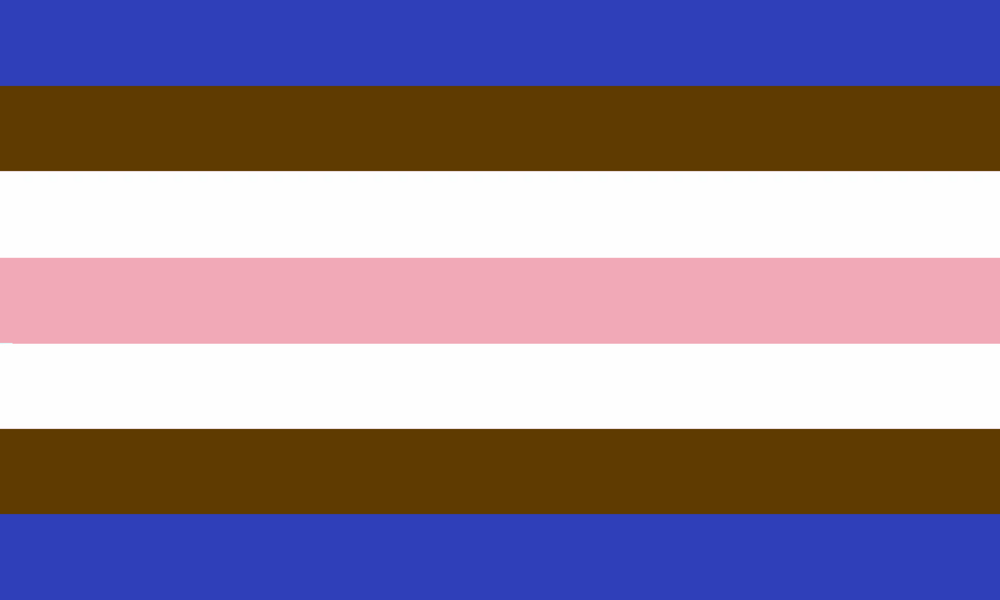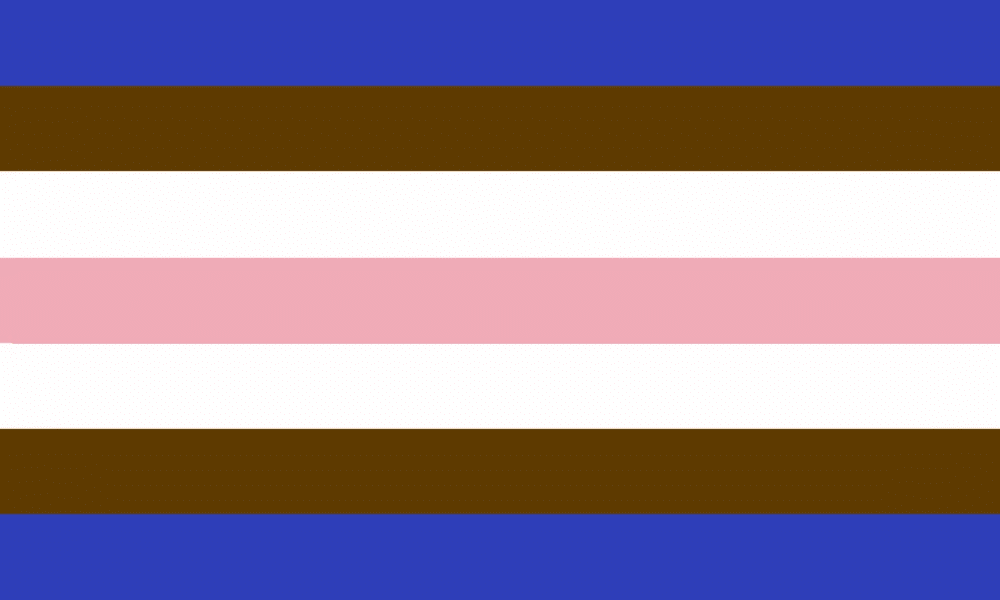Tomboy: Meaning, Gender Expression and History
 Tomboy flag
Tomboy flag
Tomboy often refers to a young girl that dresses in a masculine manner and enjoys typical manly activities over girl activities. Tomboys prefer jeans over dresses, rock their hair short or tied up, and like wearing hats. Many queer women and non-binary people go through a tomboy phase while going through gender exploration of their expression.
Tomboy traits are often common for girls considered boyish. Young women are commonly stuck with a tomboy label if they have a more masculine-leaning style. Tomboy people often enjoy outdoor physical strength activities but there are many girls who express their gender as tomboys and enjoy being indoors.
Table of Content
Tomboy – What is it? What does it mean?
Tomboy often refers to a young girl that dresses in a masculine manner and enjoys typical manly activities over girl activities. Tomboys prefer to wear pants and jeans over dresses, rock their hair short or tied up, and like hats. Many queer adult women and non-binary people go through a tomboy phase while exploring ways to express who they are.
Tomboy traits are often common for girls considered boyish. Youthful women are commonly stuck with a tomboy label if they have a more masculine-leaning style. Tomboy people often enjoy outdoor physical strength activities but there are many girls who express their gender as tomboys and enjoy being indoors.
Terminology
Here are some definitions for individuals seeking out education on the topic of tomboys. There may be additional literature available at this form of expression on other LGBTQIA+ supporting websites. Understanding the terminology is half the battle.
Tomboy
Merriam-Webster dictionary defines the term tomboy as: “a girl who behaves in a manner usually considered boyish”
This standard Merriam-Webster meaning implies that a tomboy will exhibit typical boyish behavior and style. Often tomboy girls don boys’ clothing and participate in athletics like baseball, like physical activities traditionally associated with men. She may be seen as a wild romping girl who behaves like a spirited or boisterous boy.
Going further back, the term was used to define a forward boy. He would have been alternately labeled as rude or boisterous.
There are similar terms in other languages. for example, while backfisch literally translates as baked fish in German, it is slang for a rambunctious little girl who acts like a boy. As she gets older, some may see her as a crude or immodest woman – although these views have faded since the mid nineteenth century (mostly).
One of the societal gender stereotypes associated with the sapphic community is that many adolescent girls often go through a tomboy phase. Sometimes sapphic gals coming to terms with their sexuality will get a tomboy label. Often a tomboy girl is exploring the infinite shades of what it means to have masculine and feminine traits.
Tomboys tend to have a gender expression and style that is more masc. Queer tomboy girls often identify as soft butch, chapstick, or butch as adults.
Some consider the word tomboy an old term with a negative connotation. The notion that a little girl child that excels in athletics and enjoys climbing is not feminine is an outdated stereotype. There are many forms to express femininity and masculinity that go beyond activities associated with clothing corresponding with the binary view of the sexes.
The term tomboy is often viewed as refusing to conform to gender roles and conventional views of what is expected of female and male children. Tomboys tend to be queer ladies but there are many straight ones who have a tomboy lifestyle.
There are many in the sapphic community who reject the concept of a tomboy phase. More and more members of this community prefer to use other similar terms to match their identity. All those categories may include terms like soft butch, chapstick, stem, or futch to describe those who lean into masculinity as a form of presentation or expression. This rejection may come from an objection to the notion that they are portraying a character with their fashion choices, or that every lesbian is destined to experiment in this way.
Tomgirl
A tomgirl is one of the newer terms. It typically refers to a man or male-identified person that does not conform to the standards of masculine behavior. Tomgirls enjoy expressing their femininity via appearance. They often have personality traits that are frequently associated with womanhood.
Butch
Butch is a term that refers to an individual’s gender identity as well as expression. Many butch lesbians have masculine characteristics but do not consider themselves tomboys. Butch people may or may not have expressed themselves as tomboys during their adolescent years.
High Femme
A high femme may be considered the opposite of a tomboy in the lesbian community. These lesbians love dresses, lipstick and express themselves in extremely feminine ways.
Girly Girl
A girly girl is a girl or a woman who has a traditionally feminine style. They typically wear makeup, pink frilly items, and skirts, enjoy feminine activities and adhere to the traditional gender binary view of a girl.
History
The origin of the term tomboy goes back several centuries according to the Merriam-Webster dictionary. Tomboy is essentially composed of two words tom and boy. Tom in the old days meant a stereotypical heterosexual manly man. It was used as a nickname for men to refer to stereotypically manly mannerisms. Boys at the time indicated not having reached adulthood or still youthful.
At the beginning of the 16th century, the original tomboy was a term primarily used to refer to tough boys who exhibited strong physical characteristics along with loud mannerisms. It was just a matter of time before by the middle of the century categories change took place. The term tomboy shifted to the female side to describe a girl who behaves in a way that may be considered boyish.
Tomboy became a term to refer to young girls as well as young women who did not fit the girlish stereotypes of society. Tomboys were girls who in their daily life had appearance, activities, and attitudes typically associated with male children.
In those days someone born a woman had to exhibit a girlish style, don the latest fashions, and have long hair. If a girl at a young age was not afraid to play with boys, climb trees, and have a personal style that was less girlish, she was deemed a tomboy. The tomboy image generated a specific idea of women and how they are supposed to act and dress.
In the eighteenth century some parenting ideas were encouraged by women such as Mary Wollstonecraft that were perceived as encouraging girls to develop character traits that exuded tomboyishness.
There was another shift in tomboy terminology in the 19th century. A healthy diet, exercise, and sensible clothing became a norm for girls and women of that time. There was much less focus on dresses and feminine code of behavior that had very limited views on physical exercise for women. This change offered more flexibility on gender expression for women. The rise of tomboys in popularity coincided with first-wave feminism in the United States. Tomboys suddenly became popular in America as an alternative to the limited views on feminine conduct.
In some cultures, tomboys are expected to outgrow their masculine behavior during puberty. They are stigmatized due to homophobia, biphobia, and transphobia. Tomboys may be viewed as a threatening figure to society that believes parents should be male and female and have a gender expression typical of men and women.
Young women who were tomboys faced a lot of backlash at the beginning of the 20th century. Some psychologists believed that tomboys tend to become lesbians. In fact, there was a perceived notion that a young woman who is a tomboy will refuse motherhood, abandon her parents, and become a lesbian. That sounds quite absurd but at the time Hollywood helped perpetuate a stereotype that a tomboy is a predatory butch lesbian.
To this day a heterosexual or gay young woman who behaves and dresses in a masculine-leaning way is often called a tomboy. A girl who behaves in a boyish manner, a girl that plays with children in a way that is associated with boys, a girl that does not respect the standard ideas of femininity is often labeled a tomboy.
Tomboy Style
Tomboy style may be described as comfortable, sensible, sporty as well as relaxed. Think baggy or loose-fitting tops combined with skinny jeans. Sometimes baggy clothes like tracksuits or loose-fitting jeans will be a part of the wardrobe. Majority of the clothes are in neutral shades like black, gray, white, maroon as well as dark blue.
Many rock a great pair of sneakers with a hoodie and jeans as their go-to swag. A few wardrobe staples are:
- Tank tops and t-shirts
- Shorts and jeans
- Sweatshirts, hoodies, baggy sweaters
- Sports bras and track pants
- Hats, hats, and more hats
Hair is also an important way to express yourself as a tomboy. Most tomboy girls have short or medium hair, but some also have long tresses they keep tied up. Styling is not that important as long as it does not take too much effort.
Tomboy women often do not wear makeup but some experiment with neutral shades and concealer. There is no right or wrong when it comes to putting on make-up if you are a tomboy.
Flags And Symbols
Two flags have come to represent the term tomboy.
Tomboy Flag
Here is a tomboy flag. It was created in 2017 by an unknown artist to represent tomboy lifestyle. The flag features seven stripes with colors representing the following:
- Light pink stands for women-aligned gender
- Blue and brown for gender non-conformity and masculinity
- Brown represents a masculine attitude
- Blue represents a masculine appearance
- White stands for trans and non-binary tomboys.
The mascgirl flag
The mascgirl flag features orange and purple gradients to represent femininity and masculinity.
Am I a Tomboy?
There really is no test to take on whether you are a tomboy or not. Granted, there are many available online that have a similar outline. A tomboy is generally a woman or a female-identifying person who expresses themselves in a traditionally masculine way through clothing, mannerisms, and attitude. They tend to have a lifestyle that involves sports and outdoor activities.
You may prefer to express yourself as as a tomboy if you:
- Like clothes from the men’s section
- Prefer sneakers over high heels
- Have short haircut
- Keep your nails short and trimmed
- Have a huge baseball hat collection
- Use male cologne or aftershave
- Play sports like soccer, basketball, volleyball and more
It is important to remember that being a tomboy does not mean that a person is transgender. Tomboy does not fall under the transgender gender identity umbrella. Tomboy is a form of expression that can be applied to people of all gender identities as well as sexual orientation on the spectrum.
Many straight, cisgender young ladies express themselves in a manner that may be labeled as tomboy. There are also many cisgender queer women as well as transgender and nonbinary people who may express themselves in the same way.
How to be Supportive of a Tomboy
First, take time to understand the challenges young girls and women face if this is their presentation. While some people are accepting, even admiring of women who proudly break boundaries to do and put on what they please, others don’t.
From its first use to this day the term tomboy is a loaded one. It’s meaning is subject to interpretation by the person using that label and whoever is on the receiving end of it. As anyone might guess, some embrace it. Others feel ambivalent and concerned that they are being pushed into fitting a stereotype.
There are many challenges associated with being a tomboy in a culture that focuses so much on the gender binary. Tomboys typically struggle with people assuming their gender identity based on their expression. A friendly reminder to everyone – never assume someone’s gender! If you are uncertain – politely ask the person.
Some straight tomboys struggle with people’s assumptions of their sexuality. Again, a word of advice from us to everyone: please never assume someone’s sexuality based on the person’s gender expression.
Often tomboy girls feel added pressure to adhere to the norms and standards of society. There are many tomboys that enjoy bending the rules and testing the waters of masculinity and femininity.
On the other hand, sometimes they enjoy putting on clothing associated with femininity or going with bold looks, but face added attention and unwanted judgment from people which may cause struggles with mental health. This may apply to anyone, but it’s important to acknowledge that adolescence is a time where self-esteem and body image struggles may make kids more sensitive to judgment about their bodies or fashion choices.
Of course, it’s impossible to discuss tomboy culture without addressing anti-transgender sentiment and how that impacts girls who may be perceived as not conforming to norms. For example, in the United States “bathroom laws” have led to cisgender gals and children being targeted – because certain members of society believe it is their right to determine who is allowed in lady’s and girls’ spaces.
As a general rule, supporting a tomboy is as simple as accepting them. No matter how you feel, ignore any temptation to fix them, or make them cuter. Life is not an eighties movie where the girl who presents like a boy gets pressured into a makeover and the rest is history. That kind of thing can have a serious impact on your relationship and their self-esteem. Instead, encourage them to embrace their look and personality. Then, on a broader level, be aware of situations where someone may be targeted, and act like a good accomplice.
Don’t make assumptions about a tomboy, who they will love, and who they are at their core. There are cis gals who are born as straight as straight can be, grow up to marry men, and still find meaning in embracing a tomboy look.
Anyone can be a source of support, but mothers and fathers must understand the lasting impact they can have. Statements of judgement and lack of acceptance can remain on a child’s psyche for decades, but so can supportive ones. Whether your kid identifies as straight, sapphic, bisexual, queer, cis, trans, or nonbinary understand that expressing who they are is a normal thing, even if it doesn’t reflect your own choices or tastes.
Resources
https://www.merriam-webster.com/dictionary/tomboy
https://taimi.com/wiki/queer-what-is-it-what-does-it-mean/
https://taimi.com/wiki/nonbinary-what-is-it-what-does-it-mean/
https://taimi.com/wiki/stem-lesbian-what-is-it-what-does-it-mean
https://taimi.com/wiki/futch-what-is-it-what-does-it-mean/
https://keywords.nyupress.org/childrens-literature/essay/tomboy/
https://www.theatlantic.com/health/archive/2017/01/tomboy/512258/
https://www.intomore.com/culture/the-evolution-of-tomboy-in-a-queer-context/
https://fashion-era.com/styling/tomboy-fashion
https://www.health.harvard.edu/blog/misgendering-what-it-is-and-why-it-matters-202107232553
https://taimi.com/wiki/nonbinary-what-is-it-what-does-it-mean///
Share this post:
What do you think?
 Tomboy flag
Tomboy flag




